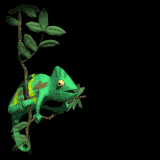YOU MISS 100% OF THE SHOTS YOU NEVER TAKE
Wayne Gretzky

The Chameleon's Tongue
DOES NOT roll out and in like a fire hose, nor
does it GROW from increased blood flow. It is not "inflated with
air" as was thought as late as the 1930's.It is actually more of a spring
loaded mechanism similar to a pinball machine releasing the ball (with a
built in retractor). It is and a very complicated process involving bones
that hold the tongue back, and muscles that release and retract it. Their tongue is as long or longer than their body. The tip
is fatter than the rest of the tongue and has a slightly sticky
wet, secretion generated by glands in the tongue tip. The tip widens
when the target is hit, and as it pulls back, it creates a slight suction,
which helps hold the food item in place. After shooting their tongue out,
the chameleon will close its eyes, much like we do when we sneeze, to help
protect them from possible damage. To protect the tongue from possible
damage, they have control only over the distance of the strike once the
tongue is released. The aim is taken before the release and can not be
changed. If a chameleon accidentally catches a non-food item, the tongue
pushes it out of the mouth.
Another controversial and interesting tongue trick done
by chameleons is a "taste test' of branches. It is believed that they
do this to determine territory claims. Their "Jacobson's organ"
(for smell) is degenerative, much like our tonsils, so it is believed that
they use this process for SMELL. Taste buds have been found in their
tongues.
Listed below are the FIVE stages of "tongue
action" involved in catching the prey, according to "Chameleons
Volume Two Care and Breeding" (see lit cited9).
Petr Necas (lit cited 7)
has a slightly different account of this process.
1. BOTH eyes lock on prey (aim).
2. The tip of the tongue is stuck out of the mouth, sort
of a sampling (protrusion).
3. The tongue is shot out and the prey is affixed to the
tip (projection).
4. The tongue returns to the mouth (retraction).
5. The prey item is chewed and swallowed (dinner)
The chameleons tongue is so unique that they were
actually once considered a separate suborder RHIPTOGLOSSA which means
"whip tongue"
BACK
TO TOP
literature cited (1,2,5,6,7)

![]()
![]()
![]()